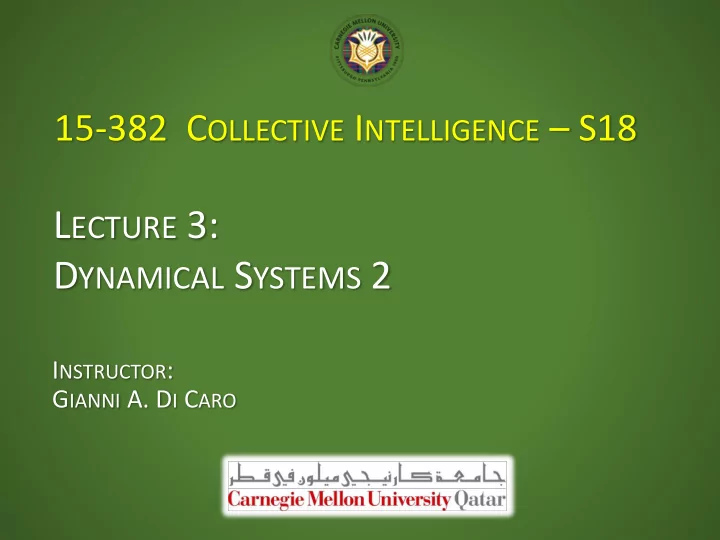

15-382 C OLLECTIVE I NTELLIGENCE – S18 L ECTURE 3: D YNAMICAL S YSTEMS 2 I NSTRUCTOR : G IANNI A. D I C ARO
ሶ ሶ V ECTOR F IELDS AND O RBITS Uncoupled system 𝒈 is a vector field in ℝ 𝑜 : a function 𝑦 = 2𝑦 = 𝑔 𝑦 (𝑦, 𝑧) associating a vector to 𝑜 -dim point 𝒚 Solution: 𝑦 0 𝑓 2𝑢 , 𝑧 0 𝑓 −3𝑢 𝑧 = −3𝑧 = 𝑔 𝑧 (𝑦, 𝑧) 𝒈 = (2𝑦, −3𝑧) Orbits / Possible trajectories Direction and speed of Flow : 𝐺(𝑢, 𝑦 𝑢 0 ) solution for any (𝑦, 𝑧) Phase portrait Vector field Rate of change, velocity Autonomous system no dependence from time, all information about the solution is represented A fundamental theorem guarantees (under differentiability and continuity assumptions) that two orbits corresponding to two different initial solutions never intersect with each other 2
ሶ ሶ V ECTOR F IELDS , O RBITS , F IXED P OINTS 𝑦 = 𝑧 = 𝑔 𝑦 (𝑦, 𝑧) 𝑧 = −𝑦 − 𝑧 2 = 𝑔 𝑧 (𝑦, 𝑧) Equilibrium point Closed (periodic) orbit Direction of increasing time 𝒚 ∗ is an equilibrium (fixed) point of the ODE if 𝒈 𝒚 ∗ = 𝟏 ↔ Once in 𝑦 ∗ , the system remains there: 𝒚 ∗ = 𝒚 𝑢; 𝒚 ∗ , 𝑢 ≥ 0 3
ሶ L INEAR MODEL FOR POPULATION GROWTH Linear model of population growth (Malthus model, 𝑦 = 𝑏𝑦 1798) Works well for small populations 𝑦(0) = 𝑦 0 𝑦 = size of population , 𝑏 = growth rate Phase portrait 𝑦(𝑢) = 𝑦 0 𝑓 𝑏𝑢 Solution orbits / Flow: (a) 𝑏 >0: Exponential growth (b) 𝑏 < 0: Exponential decrease 4
L OGISTIC MODEL FOR POPULATION GROWTH 𝑒𝑂 𝑒𝑢 = 𝑔(𝑂) General form for population growth: What is a good model that captures essential aspects? Every living organism must have at least one parent of like kind In a finite space, due to the limiting effect of the environment, there is an upper limit to the number of organisms that can occupy that space: resources competition constraint Logistic model (1838), non-linear: 𝑠 = intrinsic rate of increase [1/t] 𝑒𝑂 𝑂 𝐷 = max carrying capacity [# individuals] 𝑒𝑢 = 𝑠𝑂 1 − 𝑂 0 = 𝑂(0) 𝐷 Non-dimensional equation with no parameters: 𝑂 0 τ = 𝑠𝑢 𝑒𝑜 (dimensionless time) 𝑒τ = 𝑜 1 − 𝑜 𝑜 0 = 𝐷 𝑜 = 𝑂 𝐷 ∈ [0,1] (dimensionless population) 5
L OGISTIC MODEL FOR POPULATION GROWTH The logistic equation, even if not linear, can be integrated by separation of variables: 𝑒𝑜 𝑒𝑜 𝑒𝑜 𝑒τ = 𝑜 1 − 𝑜 , 𝑜 1−𝑜 = 𝑒τ, 𝑜 1−𝑜 = 𝑒τ න 𝑒𝑜 𝑒𝑜 ln 𝑜 − ln 1 − 𝑜 = τ + 𝐿 𝑜 + න 1 − 𝑜 = න 𝑒τ ln 1 − 𝑜 1 1 𝑜 = 1 + 𝑏𝑓 − τ 𝑜 − 1 = 𝑓 − τ −𝐿 = − τ − 𝐿 𝑜 1 The integration constant 𝑏 depends on 𝑜(τ) = the initial condition 𝑜 0 1 + 𝑏𝑓 − τ 𝐵 = 𝐷 − 𝑂 0 𝐷 𝑂(𝑢) = 𝑂 0 1 + 𝐵𝑓 −𝑠𝑢 6
L OGISTIC MODEL FOR POPULATION GROWTH Equilibrium points: 1 𝑜(τ) = 𝑔 𝑜 = 𝑜 1 − 𝑜 = 0 𝑜 = 1, 𝑜 = 0 1 + 𝑏𝑓 − τ 𝑜 Phase 𝑜 = 1 𝑜 𝑜 portrait 𝑜 = 0 𝑜 = 1 𝑜 = 0 Asymptotic divergence Flow, different 𝑏 values 𝑏 =1 Flow function 𝐺(𝑢, 𝑜 0 ) is not defined for all values of 𝑢 7
( BASIC ) L OGISTIC MODEL : D OES IT WORK ? Predict population in 1900 and 1950 Population of the US in 1800: 5.3 millions Population of the US in 1850: 23.1 millions Answer: 76 (1900), 150.7 (1950) Let’s look first at what the linear (i.e., exponential growth ) model would predict: 𝑂(𝑢) = 𝑂 0 𝑓 𝑏𝑢 We need first to derive an estimate for growth parameter 𝑏 : 𝑂(1850) = 𝑂(1800)𝑓 𝑏𝑢 23.1 = 5.3 𝑓 50𝑏 𝑏 = 0.29 𝑂 1900 = 𝑂 1800 𝑓 0.29∙100 = 100.7 𝑂 1950 = 𝑂 1800 𝑓 0.29∙150 = 438.8 The non-linear (i.e., logistic growth ) model in the dimensional form has two parameters We need more information: let’s assume we know the 1900 answer: 𝐷 𝑂(1850) = 1+ 𝐷−5.3 𝑓 −50𝑠 /5.3 = 23.1 1 + 𝐵𝑓 −𝑠𝑢 𝐵 = 𝐷 − 𝑂 0 𝐷 𝑠 = 0.031 𝑂 𝑢 = 𝑂 0 𝐷 = 189.4 𝐷 𝑂(1900) = 1+ 𝐷−5.3 𝑓 −50𝑠 /5.3 = 76 189.4 𝑂 𝑢 = (the baby boom is 𝑂 1950 = 144.7 1 + 34.74𝑓 −0.031𝑢 not accounted!) 8
L OGISTIC MODEL VS . E XPONENTIAL GROWTH ● real population values in the US ▬ Logistic model predictions Exponential explosion Logistic ● real population values in the US asymptote ▬ Logistic model predictions Little difference for small populations Both linear and logistic model work well 9
Recommend
More recommend